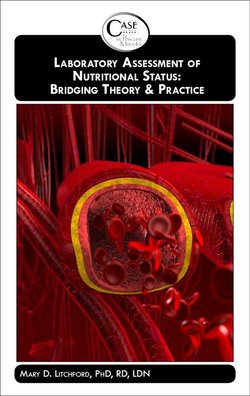Laboratory Assessment of Nutritional Status: Bridging Theory & Practice

Реклама. ООО «ЛитРес», ИНН: 7719571260.
Оглавление
MARY LITCHFORD. Laboratory Assessment of Nutritional Status: Bridging Theory & Practice
Greensboro, NC
Table of Contents
Introduction & Objectives
Overview
Implications of Selected Laboratory Tests
Changes in Nutritional Status
Impact of Inflammation
Reference Standards
Equipment
Considerations for Requesting Laboratory Tests
Communication of Results
Clinical Laboratory Values
Table 3. Abbreviations & Units of Measurement
Implications for Practice
Biochemical Assessment of Nutritional Status
Blood
Urine
Assessment of Hydration Status
Assessment of Protein Status
Nutritional Anemias
Classification of Anemias
Deficient Erythropoiesis
Excessive Hemolysis
Categories of Nutritional Anemias
Review Questions for Critical Thinking
Laboratory Reference. Alanine Aminotransferase (ALT)
Alkaline Phosphatase (ALP)
Ammonia, Blood
Apolipoprotein A & B, (Apo A-I, Apo B, Apo A-I/ Apo B ratio), Lipoprotein (a [Lp(a)], Apolipoprotein E (Apo E)
Arterial Blood Gases (ABGs) (pH, Bicarbonate (HCO3), Carbon Dioxide (CO2), PCO2, PO2, O2 saturation)
Aspartate Aminotransferase (AST) (formerly SGOT)
Bilirubin, Blood & Urine
Blood Urea Nitrogen (BUN)
C- Reactive Protein (CRP); High Sensitivity- C-Reactive Protein
Calcium (Ca), Blood
Calcium (Ca), Urine
Chloride
Cholesterol, Total Serum, LDL, HDL & VLDL
Cortisol, Blood & Urine
Creatine Kinase (CK) (formerly Creatine Phosphokinase CPK)
Creatinine Clearance
Creatinine, Serum
Creatinine, Urine
Erythrocyte Sedimentation Rate (ESR)
Ferritin
Fibrinogen (Factor I, Quantitative Fibrinogen)
Folate, Serum & Red Cell Folate (RBC Folate)
Glucose, Blood
Glucose, Blood, Post Prandial (PPG)
Glucose Tolerance Test, Oral (GTT)
Glucose, Urine
Glucose-6-Phosphate Dehydrogenase (G-6-PD)
Glycosylated Hemoglobin (A1C)
Hematocrit (HCT) or Packed Cell Volume (PCV)
Hemoglobin (HGB) Normal Values
Homocysteine (Hcy)
Iron Level (Serum Fe, Total Iron Binding Capacity (TIBC), Transferrin, Transferrin Saturation)
Serum Fe
Lactic Dehydrogenase (LDH)
Magnesium (Mg++), serum & Urine
Methyl Malonic Acid (MMA), serum & Urine
Natriuretic Peptides (Atrial Natriuretic Peptide, Brain Natriuretic Peptide, N-terminal fragment of Pro-Brain Natriuretic Peptide)
Osmolality, Serum
Osmolality, Urine
Phosphate (PO4, Phosphorus)
Potassium (K+), Serum
Potassium (K+), Urine
Protein, Blood (Retinol Binding Protein, Prealbumin, Serum Albumin, Serum Globulin & Total Protein)
Globulin
Protein, Urine (Total Protein, Albumin, Microalbumin)
Prothrombin Time (PT) & International Normalized Ratio (INR)
Red Blood Cell Indices (Mean Corpuscular Volume, Mean Corpuscular Hemoglobin, Mean Corpuscular Hemoglobin Concentration, Red Cell Distribution Width)
Reticulocyte Count (Retic Count), Reticulocyte Index
Schilling Test; Vitamin B12 Absorption Test
SODIUM (NA+), SERUM
Sodium (na+), Urine
Specific Gravity, Urine
Thiamin (B1)
Thyroid Function Tests (Thyroid-Stimulating Hormone (TSH), Thyrotropin-Releasing Hormone (TRH), Thyroxine-Binding Globulin (TBG), Thyroxine (T4), Free Thyroxine (T4), Free Thyroxine Index (FTI), Triiodothyronine(T3), Free Triiodothyronine (Free T3)
Triglycerides
Troponin (Cardiac-specific Troponin [cTnT], Cardiac-Specific I [cTnI]
Vitamin A, Retinol
Vitamin B6
Vitamin B12
Vitamin D, 25(OH)D
Vitamin E
White Blood Cell(WBC) Count & Differential Count
Neutrophils
Lymphocytes
Monocytes
Basophils & Eosinophils
Zinc (Zn), Plasma
References
Отрывок из книги
New technologies and innovative processes generate new information giving the practitioner a greater understanding of the cascade of events from diagnosis through treatment and outcomes. The Nutrition Care Process (NCP) is an innovative process in which nutrition care indicators are clustered together to identify nutrition diagnoses. Laboratory data remains one of the key components of the assessment section and is often incorporated into the PES statements.
Changes in laboratory values reflect changes in medical condition, but not always nutritional status. Be alert to all the factors that contribute to changes in laboratory values. Changes in nutritional status mean the plan of care is achieving the expected outcomes or it is not achieving the expected outcomes. Improving nutritional status usually means shorter hospital stays, fewer complications and speedier wound healing after surgery. Using laboratory assessment to document the positive impact of the medical nutrition therapy demonstrates the benefits of our professional expertise to the medical team.
.....
Key: WNL= within normal limits
Assessment FOR Overhydration
.....